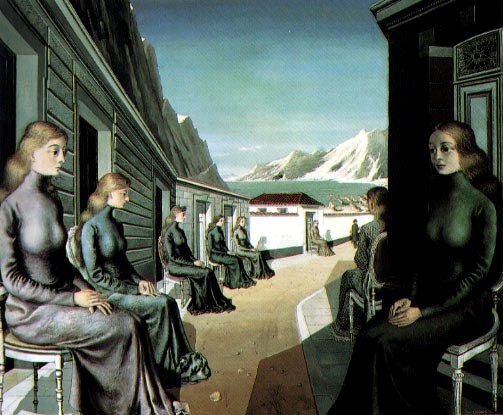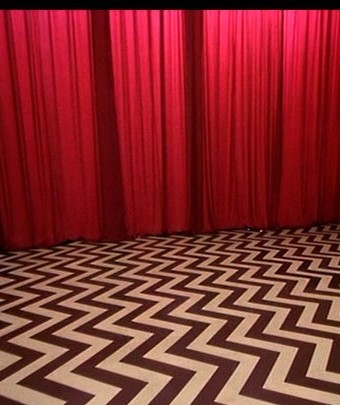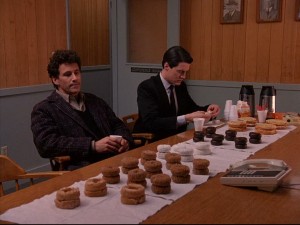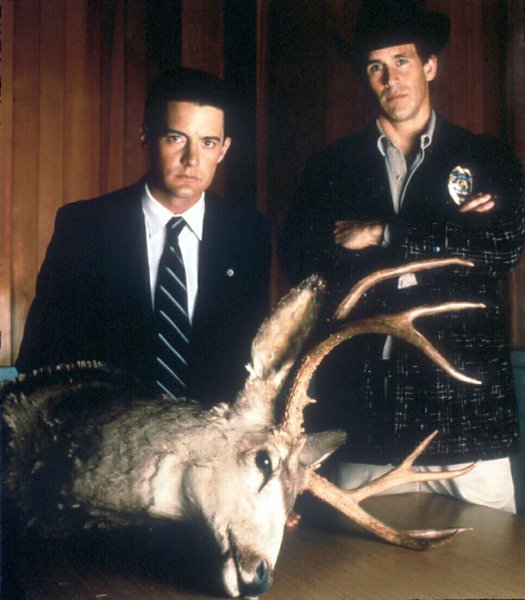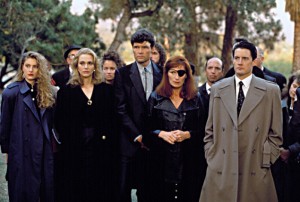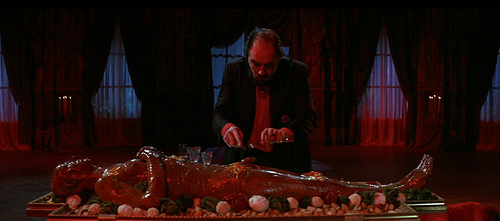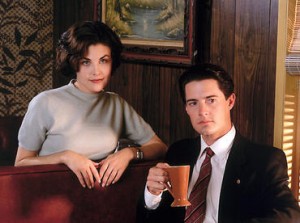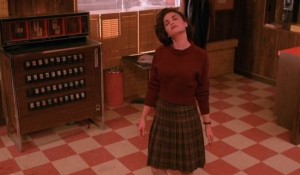The following article, which originally appeared in the April 20, 1990 issue of the Chicago Reader, without any star rating, is the only time I can recall writing at length in the Reader about an American TV series. (An edited version of this piece appears in a 1995 collection edited by David Lavery for Wayne State University Press, Full of Secrets: Critical Approaches to Twin Peaks, under the title “Bad Ideas: The Art and Politics of Twin Peaks“.) From a vantage point of almost two decades later, I wouldn’t be as quick today to insist that David Lynch’s work is devoid of any social commentary. What he has to say about the Hollywood community alone, especially in Inland Empire (2006), shows that he’s no longer as detached as he was.
Another invaluable tool for re-evaluation is the recent and superbly appointed Blu-Ray box set devoted to Twin Peaks. Despite some misgivings about the show’s second season (see, for instance, Martha Nochimson’s demurrals in her 1997 The Passion of David Lynch about some of the ways the show “perverted” Lynch’s original designs and conceptions), I continue to find much of it very absorbing. The same is true, so far, about the so-far uneven third season, despite the brilliance of the third episode. — J.R.
TWIN PEAKS
Directed and written by David Lynch, Mark Frost, and others.
With Kyle MacLachlan, Michael Ontkean, Piper Laurie, Joan Chen, Madchen Amick, Dana Ashbrook, and Richard Beymer.
In my opinion, the first problem — the most important problem in our world — is the problem of dissemination, and it’s the conception of this dissemination that may lead to catastrophe. . . . The way it’s used now, the influence of the masses leads to nothing but the scattering of material. For example, think of a liter of wine: it’s certainly sufficient when shared by three or four people. But if we want this same liter of wine to be shared by one thousand people, we have to put water in it, and then it’s useless. We have to wonder whether something like this doesn’t happen in the process of dissemination. — Jean Renoir, 1957
“Wars, conflict — it’s all business. One murder makes a villain, millions a hero. Numbers sanctify, my good fellow.” The remark of Monsieur Verdoux to a reporter near the end of Charlie Chaplin’s 1947 feature finds a striking application in the media’s response to David Lynch over the past 13 years. When the remarkable and independent Eraserhead, his first and by all counts most artistic feature, received its world premiere at Los Angeles’s Filmex on March 19, 1977, the review in Variety was far from enthusiastic. “Dismal American Film Institute exercise in gore,” ran the headline, adding, “Commercial prospects nil.” The review conceded that this “sickening bad-taste exercise” had “good tech values (particularly the inventive sound mixing), but little substance or subtlety. . . . Lynch seems bent on emulating Herschell Gordon Lewis, the king of low-budget gore.”
Two and a half years later, after Eraserhead had gone on to achieve some success as a midnight feature, it opened for a week’s run at New York’s Cinema II. It did dismal business, and the New York Times gave it a review that was every bit as hostile and dismissive as the one in Variety, calling it “murkily pretentious,” “interminable,” and “sophomoric.” But over the past decade, Lynch has gradually learned how to expand his audience by working in more popular forms — in The Elephant Man, Dune, Blue Velvet, and now, watering down his eccentricity and artistry still further, in the TV miniseries Twin Peaks, the pilot of which was broadcast on ABC on April 7. And the response of both the media and his audience to this development has been little short of rapturous.
“The year’s best show!” crowed the cover of Entertainment Weekly; “the wingdingiest thing to make it onto network television in many a full moon,” echoed Ken Tucker in the same magazine. “An erotic watershed in the history of broadcast TV,” claimed Amy Taubin in the Village Voice. “As in a Fellini film, strange moments abound,” wrote Timothy Carlson in TV Guide. And in the New Yorker Terrence Rafferty called it “an exhilarating ride, at once scary and mysteriously tranquil, like the children’s nighttime journey down the river in The Night of the Hunter.” This followed a favorable comparison of Twin Peaks to Buñuel’s The Discreet Charm of the Bourgeoisie, in which Rafferty went so far as to imagine Buñuel turning his film into an extended TV series as well.
It’s hard to quarrel with the enthusiasm of the TV reviewers. In the context of mainstream television, even diluted Lynch is a welcome jolt. But when movie critics start comparing Twin Peaks to art films, it’s time to wonder whether someone — critic or reader — is being sold a bill of goods.
Though it seems reasonable enough to regard Lynch, the director and cowriter (with Mark Frost) of the pilot, a surrealist, linking him with the Latin surrealism of a Buñuel (or even the Latin semi-surrealism of a Fellini) is a grotesque kind of shorthand, one that pares away most of what makes both filmmakers distinctive. The drier Belgian surrealism of painters like Paul Delvaux and Rene Magritte [see below] — bourgeois surrealists whose nearest well-known American equivalent might be Edward Hopper — is much closer to Lynch’s turf, as is the Belgian filmmaker Chantal Akerman. All these artists excel in taking familiar bourgeois settings and situations and eroding them with creepy undertones, a lingering sense of disquiet — a tactic that is quite different from inflating them into cartoons (Fellini), turning them into poetic fairy-tale landscapes (Charles Laughton’s The Night of the Hunter), or exploding them (Buñuel).
This distinction is important because Surrealism as an organized movement began largely as social protest, with Buñuel one of its most committed members throughout the span of his career. (To imagine Buñuel turning one of his most corrosive masterpieces into a TV series is roughly tantamount to imagining Eisenstein directing one of the Rambo sequels.) Lynch, by contrast, has never shown the slightest inclination toward social commentary, much less protest. Eraserhead, a very private meditation about fears concerning sex, procreation, and parenthood, is founded on a certain biological determinism that is pessimistic and conservative in its implications, with no hint of any social analysis in sight. The Elephant Man and Dune, both of which were inherited by Lynch and based on books, are a little harder to judge, but neither seems very engaged with the social aspects of its material; the fake piety of the former and the awkward, mechanical exposition of the latter both suggest that Lynch was essentially mining the stories for opportunities to “do his thing.” Lynch’s social orientation becomes much clearer with Blue Velvet, and now Twin Peaks: it consists basically of an infatuation with 50s small-town America and its dirty little secrets, coupled with a view of women that essentially regards them as either madonnas or whores. A nostalgic regression, in short, to the worst aspects of the Eisenhower era — the site of his adolescence — represents the sum of Lynch’s social agenda, which is light-years away from that of Luis Buñuel.
If I’ve singled out Terrence Rafferty for attack, it’s only because his review expresses the desire to liberate Twin Peaks from its ideology even more nakedly than the other forms of hype I’ve encountered. There’s something wistfully, desperately, and quintessentially American, as well as postmodernist, about collapsing a Marxist anarchist devoted to the overthrow of bourgeois complacency (and, initially, of civilization itself) into a formalist with no interest whatever in altering the status quo. (“I couldn’t care less about changing the conventions of mainstream television,” Lynch remarked in an interview published in the London newspaper the Independent last November; he repeats the same sentiment in the current issue of Elle, and there’s no reason to doubt his sincerity.)
Under the circumstances, it seems useful to point out that with a sheriff and a federal agent as its principal charismatic male buddies, a sentimentality about homecoming queens that borders on gush, a Reaganite preference for the wealthy over the poor (and for WASPS over everyone else), and a puritanical Peyton Place brand of sociology, Twin Peaks is ideologically no different from other prime-time serials; if it is supposed to be leading us to the promised land, it is still hauling the worst of our 80s and 90s baggage along with us. Lynch’s attitude toward this baggage, moreover, seems not so much committed as expedient. One might simply say that he’s an artist who likes to hang his work — his arresting compositions, weird ideas, and haunting sounds — in the biggest museums he can find; prime-time TV, baggage and all, offers the biggest museum in the world.
The distance traveled by Lynch in prestige from Herschell Gordon Lewis to Buñuel and Fellini is certainly not a matter of any increase in craft or artistic maturity—or, rather, it is only if one identifies these values exclusively with a capacity to reach a wider audience. It can be argued, for instance, that the absence of Alan Splet on Twin Peaks—the prodigious sound technician on Lynch’s previous features—points to a corresponding shrinkage in the originality, range, and effectiveness of Lynch’s aural palette. And seen more generally in terms of Lynch’s career as a “pure” artist following his own bents, Twin Peaks is in many ways as much of a step down from Blue Velvet as that film was from Eraserhead.
But context has a way of changing everything; as Chaplin’s Verdoux puts it, “Numbers sanctify,” and because we live in a culture where it’s generally considered more important for watered-down wine to reach a thousand people than for the pure stuff to reach three or four, the progressive watering down of Lynch’s art has generally been applauded. The two-hour Twin Peaks pilot wound up reaching almost 20 million households, roughly twice the number watching any competing show, and the first regular one-hour episode, four nights later, nearly tied in ratings with the popular sitcom Cheers. The fact that a media blitz helped to gain the show its initial audience only serves to intensify the process of Lynch’s upgrading—giving the hype some of the aspects of a self-fulfilling prophecy.
***
In order to get a clear sense of what Twin Peaks is actually up to, one must consider both its authorship and the open-ended nature of the series. Only the pilot and episode number 2 (the third installment counting the pilot, to be shown April 19) were directed by Lynch; he cowrote the pilot and first two episodes with TV veteran Mark Frost, and he and Frost served as executive producers on all seven episodes, which means they supervised and approved all that they weren’t directly involved in. Frost wrote episodes 5 and 7 single-handedly and directed 7; the other directors in the series include film editor Dwayne Dunham (1), who edited the pilot; Tina Rathbone (3), who directed the recent Zelly and Me (in which Lynch costarred); Tim Hunter (4), whose best-known directorial credits are Tex and River’s Edge; and cinematographer Caleb Deschanel (6), who directed The Escape Artist.
Several separate endings to the series have already been filmed by Lynch, and the question of which one will be used on American TV largely depends on whether or not the series becomes a regular show in the fall. The pilot is currently available on video in 13 other countries in a version that’s 18 minutes longer, including an epilogue set 25 years in the future. When and how this longer version of the pilot will become available in the U.S. is not yet clear, but what is clear from various overseas reviews is that the epilogue leaves a good many plot questions hanging; although the torturer and murderer of Laura and other female victims is revealed, the resolution has been described as “arbitrary,” and one that leaves a lot of red herrings in its wake. (The epilogue, moreover, to judge from descriptions in both Monthly Film Bulletin and Cahiers du Cinéma, is more avant-garde and less explicable in narrative terms than anything in the pilot.)
Lynch’s major achievement in all this is that he plays strictly by the dubious rules of his elected genre and still finds numerous opportunities to display his quirky humor and other forms of aesthetic distancing. The results are both formulaic and goofy — a far cry from the overall coherence of an Eraserhead (or a Feuillade serial, to cite another of Terrence Rafferty’s strained comparisons), but certainly a bright development in a moribund genre, and a story that sets up enough mysteries to get some genuine momentum going. (Whatever my doubts or misgivings about the series as a whole, I expect to stay plugged in through the final episode on May 24.)
The novel elements of the two-hour pilot have little to do with basic aspects of the characters or plot; rather they are matters of mise en scène and certain areas of emphasis involving quirks in the characters and plot. One of my favorite quirky moments occurs close to the beginning, following a credit sequence comprising tranquil views of the fictional northwestern town of Twin Peaks. Pete Martell (played by Lynch regular Jack Nance) discovers the nude body of a tortured and murdered teenage girl named Laura Palmer wrapped in plastic beside a lake; he calls the sheriff’s office in shock, and the sheriff’s secretary Lucy (Kimmy Robertson) summons the sheriff (Michael Ontkean) — who happens to be named Harry S. Truman—to the phone in the following manner: “I’m going to transfer it, the phone on the table by the red chair—the red chair against the wall. The little table with the lamp on it—the lamp that we moved from the corner? The black phone, not the brown phone.”
This totally inessential and daffy piece of confusion injected into a grim (if generic) moment is an early signal that Lynch’s auteurist identity is mainly going to proceed neither with nor through the plot, but at oblique angles to it. This is pretty much the pattern that he follows throughout the pilot—carving out little pockets in the mechanical plot and creating shapely formalist designs inside them. Where these designs differ most from those in his previous pictures is in his willingness to adapt them to the purely narrative dictates of the serial form. If a fluorescent light splutters over Laura’s corpse in the morgue, creating a typically Lynchian visual and rhythmic pattern, there’s a line of dialogue by an attendant (“I think it’s a bad transformer”) that serves to account for it. If a gigantic elk’s head covers much of a table in a small room where the sheriff and federal agent Dale Cooper (Kyle MacLachlan) are about to examine the contents of Laura’s secret safety-deposit box, you can be sure that someone—in this case a bank assistant—will naturalistically justify this anomaly as well (“Oh—it fell down”). Even the brief oddball appearance of Johnny Horne (Robert Davenport)—a 27-year-old in an Indian headdress who grieves over Laura’s absence by slowly beating his head against a doll’s house—is eventually rationalized or “justified.” He is only half accounted for in the pilot, but in episode 1 his kid sister Audrey (Sherilyn Fenn) explains to Cooper that her brother, whom Laura used to tutor, is still in the third grade and has “emotional problems.”
What emerges from the pilot is a kind of ongoing working arrangement between bourgeois surrealism and conventional narrative—a relationship that probably reflects to some degree the collaboration between Lynch and veteran TV writer Frost. (This ambivalent structure is both reflected and to some extent mediated by Angelo Badalamenti’s Morricone-like wallpaper score, providing a highly emotional main theme that alternately comes across as “sincere” and as somewhat facetious, as well as some drier and more noncommittal stretches featuring cool jazz.) Some of this same pattern can be found in the collaboration between the characters Dale Cooper and Harry S. Truman as they pursue the mystery together, forming a duo that suggests Sherlock Holmes and Watson (a link explicitly acknowledged by Truman in the first episode), the eccentric artist-detective and the square straight man who marvels at his deductions—except in this case it is the supersleuth, Cooper, who serves as unofficial narrator, continually speaking into a small cassette recorder to an unseen secretary named Diane.
This sort of evenly poised aesthetic balance—or, if one prefers, schizophrenia—between weirdness and normality is regrettably upset in episode 1, directed by Dwayne Dunham from a script by Frost and Lynch; here the series reverts to a mise en scène that is much closer to TV norms. Although the opening shot features an elaborate and extended pan around Cooper’s hotel room that proceeds down his entire body as he hangs by his feet from a ceiling bar, the overall effect is more fancy than artistic. Much later in the episode, a couple of subjective shots from the viewpoint of Laura’s grief-stricken mother—a sudden superimposition of Laura’s face over the face of her best friend, and an almost subliminal flashback glimpse of a strange fellow who may or may not be the killer—are marginally effective without being either beautiful or hallucinatory in the Lynchian manner. Even more regrettable, though not surprising, Dunham’s direction of the actors, while competent enough on a conventional level, squelches much of the spooky wit in the dialogue. With six more episodes to go—and even more if the show turns into a regular series by fall—Cooper’s improbable deductive powers and his obsession with restaurant food like cherry pie are already becoming a bit tiresome and flat, like the unvarying bits that are virtually de rigueur in an ongoing serial format. Lynchian details still crop up in the story at regular intervals—a fish in a coffee maker, a cigarette planted like a candle in a slice of cake, the second appearance of a rather mystical character known as the Log Lady—but without Lynch to realize them on screen, they lose much of their punch and vibrancy. By the time we get to the third episode, which does without Lynch’s direction and his writing, it is altogether possible that Twin Peaks will have become a soap opera with relatively little distinction at all.
***
ABC’s willingness to experiment with a show like Twin Peaks comes at a time when network TV, feeling the heat from both cable and video rentals, is clearly in trouble with a shrinking audience. The question of whether Lynch and Frost’s show may help to turn the tide by encouraging more experimentation is an important one, but it shouldn’t be confused with an appraisal of Twin Peaks in relation to Lynch’s other work, or even an appraisal on its own merits. Having at this point seen only a third of the nine hours produced so far, I obviously can’t pretend to make any final judgments on the whole, but the precipitous decline in overall quality between the pilot and first episode is not encouraging.
Part of what so far seems to make the show a “winner” in terms of contemporary taste is its distance from humanism, a quality that can also be found in Peter Greenaway’s current art-house hit The Cook, the Thief, His Wife & Her Lover. This distance is correctly perceived as a certain kind of artistic freedom. Both Lynch and Greenaway started out as painters who turned to experimental filmmaking before they adopted more mainstream narrative tactics, and both can be described as formalists whose imaginative freedom largely consists of their capacity to work outside the moral categories that restrict most forms of humanist fiction. In other respects they are quite different—Lynch is intuitive and poetic while Greenaway is intellectual and systematic—but the recent fascination of both filmmakers with violence, eroticism, cruelty, and suffering, unaccompanied by the usual varieties and amounts of empathy, give their latest works a cold, pornographic luster whose widespread morbid appeal is surely telling us something about the temper of our times.
I’m not sure what it says about me to admit that I find Lynch’s brand of antihumanism, which is characterized by the preoccupations of male adolescence, a lot more alluring than Greenaway’s, which is characterized to the same degree by the preoccupations of a middle-aged male. (Even the name of Lynch’s town and show can be read as a horny male teenager’s term for female breasts.) I’m certainly bored stiff by most of the teenagers in Twin Peaks, apart from the giddy and sexy amorality of Audrey Horne, but the adolescent eye trained on the other characters is something else again—it makes the corruption of adults look fresh because it is viewed as if by someone who is innocent enough to be discovering corruption for the first time.
A similarly fresh and alien quality is imparted to the grief that the adults of Twin Peaks display after the discovery of Laura’s body. The tears of the sheriff’s deputy, both of Laura’s parents, and the high school principal are lingered over with a kind of numb, abnormal curiosity that suspends the narrative well past the point of conventional movies, much less soap opera. (Laura’s mother Sarah receives most of this attention, and her initial crying even provokes one of Lynch’s formalist pirouettes—a slow camera movement from an overturned phone down its cord to the dangling receiver.) Some of the teenagers, notably Donna and James, are shown crying at some length as well, but these stretches are usually more recuperable as prime-time tearjerk material, while the wailing grown-ups are converted more into slightly uncanny art objects, regarded with the same kind of inquisitiveness that a 13-year-old might have about, say, an exotic beetle. This singular angle of vision has been part of Lynch’s equipment from the beginning, and it surely says a lot about both him and his audience, not to mention his country, that Twin Peaks would be–and may even, by the end of the series, turn out to be–as flat as stale beer without it.




